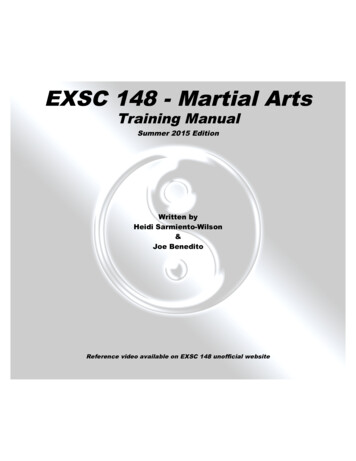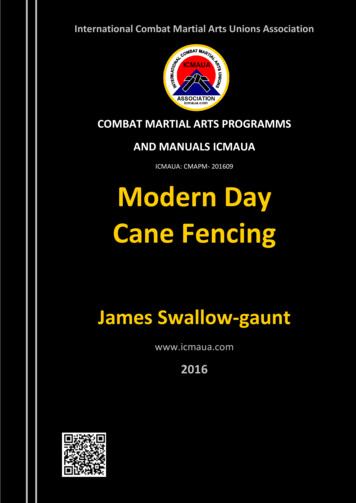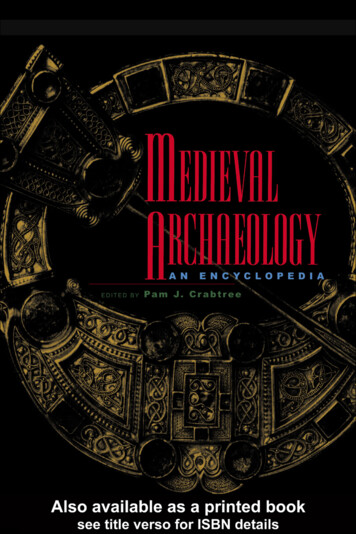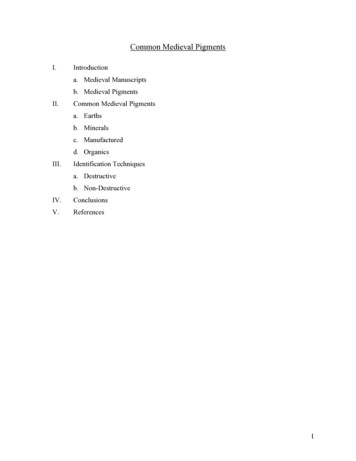
Transcription
Academy of European MedievalMartial Arts (AEMMA)Hans Talhoffer“Fechtbuch aus dem Jahre 1467”The following document is the result of the efforts of a number of individuals within the AEMMAmembership, including Shawn Hickey, Scott Walman and Mike Rasmusson. The purpose of thedocument is to simply present in printer-friendly form, content that is currently available in the onlinelibrary of the AEMMA web site to help facilitate medieval martial arts studies.Many of the initial translations were the result of the work by Mark Rector in September – November,1998, prior to his recent publication and therefore, cannot be consider copyright infringement on thepart of this document. However, any new translations made available will be highlighted as an“AEMMA comment” in the text.DistributionFeel free to distribute this document, either electronically or hard copy in an un-altered state. Do notprofit from this and other documents made available on the AEMMA web site.Further InformationThis and other documents and manuscripts are available online in the online library area of the AEMMAweb site located at http://www.aemma.org. For more information, queries or comments, feel free toemail AEMMA at info@aemma.org .
Hans Talhoffer: “Fechtbuch aus dem Jahre 1467” – for personal study onlyContentsTalhoffer’s Fechtbuchs: an Introduction. 3(1) Langes Schwert (The Long Sword) - plates 1 – 67. 5(2) Kämpfe in den Schranken mit Spiess und Schwert in voller Rüstung (Fight in the Lists with Spear and Sword inFull Armor) - plates 68 – 73. 38(3) Langes Schwert (The Long Sword – Half-sword Techniques). 39(4) Streitaxt (Pole-axe) - plates 79 - 103. 41(9) Degen (Dolch) (Dagger) - plates 170 – 190. 54(10) Ringen (Wrestling) - plates 191 - 221 . 66Sourced from AEMMA – www.aemma.org211/07/00
Hans Talhoffer: “Fechtbuch aus dem Jahre 1467” – for personal study onlyTalhoffer’s Fechtbuchs: an Introductionby Michael Lacy, Ph.D (History)It is a common misconception that the combat in the medieval period was crude and haphazard, relyingon brute strength over skill. Victorian authors such as Egerton Castle, one of the premier historians ofswordplay of his time, derided the “rough untutored fighting of the Middle Ages”and compared in unfavourably with the elegance and grace of later period rapier play. Modern scholars,however, take a different much different view of the martial skills of medieval warriors. A careful studyof surviving combat manuals (fechtbuchs, in German) gives every indication thatWestern martial arts were every bit as sophisticated as those of the East. Three surviving treatises onlate medieval combat written by Hans Talhoffer are perhaps the best known of these rare documents asthey were reprinted at the beginning of this century by an officer in theAustria-Hungarian Empire by the name of Gustave Hergsell. Hans Talhoffer was from Swabia, a regionof Southern Germany which now lies chiefly within the present states of Baden-Wurttemberg andBavaria. This region derived its name from the Suevi, a Germanic tribe which settled in the area duringthe great migrations of the fifth century. Swabia was long famed for its martial traditions, and by thefifteenth century the techniques its master swordsmen, such as Johannes Liechtenauer, had influencedfight manuals both in Germany and Italy. An unfinished fechtbuch of 1389 written by HankoDoebringer, possibly a pupil of Liechtenaur, sets out much of his masters’ theory. Matthew Galas, anindependent scholar who is preparing a book on early German swordsmanship, writes of this fechtbuch;“Despite his failure to complete his work, Doebringer manages to convey the theoreticalbasis for the German art, which is surprisingly modern in tone. Concentrating on theimportance of seizing the initiative, on maintaining the offensive, and evading theopponent’s attempts to find the blade, Doebringer at times sounds like a modern epeecoach. In another section, Doebringer discusses the time advantage of the thrust over thecut &endash; a theoretical concept usually ascribed to the Italian rapier masters. Inaddition, Doebringer describes how Liechtenauer divided the opponent’s body into fourtarget areas - a division still used in modern fencing. Finally, dispelling the misconceptionthat medieval swordsmen relied on strength alone, Doebringer states that a weaklingusing Liechtenauer’s art would be as likely to win as a strong man. In sum, HankoDoebringer’s observations make clear that medieval fencing masters - at least inGermany &endash; had developed their art to a much higher degree of sophisticationthan they have previously been given credit for.” (Galas, M., “Setting The RecordStraight: The Art of the Sword in Medieval Europe”)The fame of the Swabian fighting arts was not confined to Germany, as the author of a early Italian fightmanual, the Flos Duellatorum (Flower of Battle, 1410) claims to have studied under a “MasterSourced from AEMMA – www.aemma.org311/07/00
Hans Talhoffer: “Fechtbuch aus dem Jahre 1467” – for personal study onlyJohannes, called the Swabian.” Talhoffer’s fechtbuchs are thus part of a long tradition of combatmanuals deriving, to a great extent from the teachings of the legendary Johannes Liechtenaur. Mr. Galas’book should be released soon, and should shed more light on this swordfighting tradition. Little isactually known about Hans Talhoffer, other than that what can be gleaned from his manuscripts. Atsome point, he seems to have been a servant to a Swabian squire (Hergsell uses the french worddamoiseau) by the name of Leutold Königsegg.* There are several illustrations in the 1459 edition of hisfechtbuch which show the author attending Königsegg in duties we would most associate with a squire.In plates 13 to 42, Talhoffer is assisting him in preparation for what appears to be a judicial duel, and isshown helping him into his armour, carrying his weapons into the list field and attending him in differenttypes of tournament armour (below).Talhoffer’s fechtbuchs survive in at least 3 editions; 1443, 1459 and 1467.** Two are preserved atGotha (1443 and 1467) and the third, formerly at Schloss Ambras, is now in Vienna. Although there isnot sufficient space in this article to examine these works in depth, I have made the following outline ofthe salient points, along with a few observations on some of the more remarkable aspects of thesefascinating documents.*A town and a castle, both named Königseggwald, can be found north of Friedrichshafen in presentday Baden-Wurttemberg. This may well be connected with Leutold’s family.**There would appear to be yet another edition at Copenhagen, mentioned in a 1987 article in Waffenund Kostümkunde, vol. 29, by Hans-Peter Hils, but I have yet to track down more information. Theillustrations from it which were in the article were of plates that do notappear to be in any of the editions printed by Hergsell, and they are of a quality to suggest that they akinto the 1467 edition, so it may well be another edition dating from around that time.Sourced from AEMMA – www.aemma.org411/07/00
Hans Talhoffer: “Fechtbuch aus dem Jahre 1467” – for personal study only(1) Langes Schwert (The Long Sword) - plates 1 – 67(tafel 1) High Guards“Oberhieb. - Unterhieb.”“Overhand cut. – Underhand cut.”Offensive: Step forward with the left legin preparation to deliver a vertical cutfrom above. Begin with the swordoverhead and pointing upwards atapproximately 450 to the horizontal,pommel positioned in front of theforehead.Defensive: From “below”, raise thesword to assume a “long guard”position, effective against a stabbingthrust, but not a downward overheadcut.(tafel 2) Twisted Thrust and Low Guard“Sturzhieb. - Wechselhieb.”“Plunging cut. - Changing cut.”Offensive: In order to avoid contactwith the long guard from the high guardposition, “twist” the sword to deliverthe cutting strike from the left targetingthe right upper shoulder or upper chest.Defensive: The low guard position isintended to defend against strikestowards the lower legs and thighs. Thisposition invites the opponent to attack,in which the low guard positioned swordcan be raised to deliver an upwardrising cut.Sourced from AEMMA – www.aemma.org511/07/00
Hans Talhoffer: “Fechtbuch aus dem Jahre 1467” – for personal study only(tafel 3) Guard of the Wrath - Middle Guard“Bedrohe mit Zornort (Stoss). - fuhrtwieder den Oberhieb.”“Menacing him with the guard ofWrath. - Again, an overhand cut.”Offensive: From the “twisted cutposition”, step forward with the rightleg and at the same time, rotate thebody towards the left in preparation todeliver a horizontal thrust. Begin withthe sword in the “twisted form” androtate the blade somewhat horizontally(like a barrel role) using the right handas the pivot point, arching from left tothe right, the left hand creating a large arch from the right to the left, with the target being theupper right neck/shoulder of the opponent. Near the completion, move the left hand to thepommel to increase the force behind the thrust.Defensive: From “below”, raise the sword high in order to assume the middle guard position, toblock the expected thrust cut and take a step backwards, leading with the left leg.(tafel 4) Extended Guard of Wrath - Crossed Guard"Der lange Zornort (Stoss). - Dagegenist der ver schrankte Ort (Stoss).""Extended guard of wrath. - Against itis the crossed guard."Offensive: From the “guard of thewrath” position, using the right hand asthe pivot, rotate the sword counterclockwise creating an arch at thepommel from the left to the right.Defensive: Taking a large step behindwith the right leg, the left foot“planted”, rotate the body clock-wiseout of the way of the oncoming thrusting cut and raise the pommel end of the sword quicklyupwards and to the right swing the point to target the opponent’s right side of the neck/head.Sourced from AEMMA – www.aemma.org611/07/00
Hans Talhoffer: “Fechtbuch aus dem Jahre 1467” – for personal study only(tafel 5) Downward Centre Cut - Throat Strike“Der freie hieb von oben. - Dagegenmache den hieb nach dem hals.”“The open cut from above. - Against itmake the cut towards the throat.”Offensive: From the “Extended guardof wrath” position, “reset” the swordwith the “Oberhieb”, left foot movedforward, and deliver a centereddownward cutting strike targeting thehead.Defensive: From the “crossed guard”,rotate the body clockwise by taking alarge step backwards and to the right with the left foot, swinging the sword outwards andtowards the left and then deliver a horizontal cut to the opponent’s right side of the neck.(tafel 6) Lower Targets“Gegen die untere Blösse. - Auchgegen die untere Blösse.”“At the lower target. - Also at thelower target.”Offensive: From the “open cut fromabove” position, pull in the sword,dropping the point and at the same time,taking a step forward with the rightfoot. The conclusion will have the swordpointed downwards against theopponent’s abdomen.Defensive: From the “throat strike”position, similarily with the offensivemaneuvre, drop the point of the sword, take a step forward with the left leg. The result will beboth in a similar position against each other.Sourced from AEMMA – www.aemma.org711/07/00
Hans Talhoffer: “Fechtbuch aus dem Jahre 1467” – for personal study only(tafel 7) Sword capture“Das Schwert mit dem Arme fassen.”“The sword captured with the arm.”Offensive: From the “lower target”position, take a step backwards with theright foot, releasing the sword with theleft hand and swinging the swordbackwards out of the way. Drop the leftarm over the opponent’s sword andcompress the sword and arm against theside with the arm.Defensive: From the “lower target”position, take a step backwards with theleft foot, while pushing the opponentwith the left hand, at the same time,pulling the sword free from the capture.(tafel 8) Face Cut“Ein Anlegen der klinge, oberzuvorkommen mit dem hieb.”“A placement (of the blade), or beforeit (the cut) arrives.”Offensive : Currently under analysis.Defensive : Currently under analysis.Sourced from AEMMA – www.aemma.org811/07/00
Hans Talhoffer: “Fechtbuch aus dem Jahre 1467” – for personal study only(tafel 9) Middle Guards“Links (Linksfechter) gegen rechts(Rechtsfechter) muss stark fechten.”“The left against the right, this onemust fence with strength.”Offensive : Currently under analysis.Defensive : Currently under analysis.(tafel 10) Open Guard & Spring“Ein freier Stoss. - Das schnellen mitder klinge.”“An open guard - The “spring” (withthe blade).”Offensive : Currently under analysis.Defensive : Currently under analysis.Sourced from AEMMA – www.aemma.org911/07/00
Hans Talhoffer: “Fechtbuch aus dem Jahre 1467” – for personal study only(tafel 11) Arm siezure“Aus dem Anbinden (Engagement)hinwegstossen und den Oberarmergreigen.”“From the bind, thrust away and seizebehind the elbow.”Offensive : Currently under analysis.Defensive : Currently under analysis.(tafel 12) Open Guard and Offensive leg“Mit dem freien Ort (Stoss) vortretenund in den Bauch treten.”“With the open guard, step forwardand stomp in the belly.”Offensive : Currently under analysis.Defensive : Currently under analysis.Sourced from AEMMA – www.aemma.org1011/07/00
Hans Talhoffer: “Fechtbuch aus dem Jahre 1467” – for personal study only(tafel 13) Upper guards“Zwei obere Ort (Stösse).”“Two upper guards.”Offensive : Currently under analysis.Defensive : Currently under analysis.(tafel 14) Lower guards“Die zwei unteren Blössen.”“The two lower targets.”Offensive : Currently under analysis.Defensive : Currently under analysis.Sourced from AEMMA – www.aemma.org1111/07/00
Hans Talhoffer: “Fechtbuch aus dem Jahre 1467” – for personal study only(tafel 15) Defensive guard“Das Entziehen der klinge. (DefensiveGarde nehmen).”“Extracting away from the bind”Offensive : Currently under analysis.Defensive : Currently under analysis.AEMMA comment: “Der klinge”translates better as “the clench” than “thebind.” We feel the translation is“Extracting from the clench.” The stance ofthe fighter on the right seems to agree withthis.(tafel 16) Guard of the Iron Door (Low guard)“Das Greifen gegen die Eisenport. Die Eisenport(hieb).”“The attack against the ‘Iron Door’. The ‘Iron Door’.”Offensive : Currently under analysis.Defensive : Currently under analysis.Sourced from AEMMA – www.aemma.org1211/07/00
Hans Talhoffer: “Fechtbuch aus dem Jahre 1467” – for personal study only(tafel 17) False feint“Den Oberhieb erlugen (fintieren), undnach dem Arm schlagen.”“The overhand false (feint) cut and theslash at his arm.”Offensive : Currently under analysis.Defensive : Currently under analysis.(tafel 18) Downward centre cut and block“Der vollführt den verschränkten Ort(Stoss). - Der haut von oben.”“This one makes the crossed guard.—The cut from above (from the roof).”Offensive : Currently under analysis.Defensive : Currently under analysis.Sourced from AEMMA – www.aemma.org1311/07/00
Hans Talhoffer: “Fechtbuch aus dem Jahre 1467” – for personal study only(tafel 19) Nimble Curving Cut“Die Krumme schnell hinauf. - kehredie spitze dagegen.”“The quick curving cut. - Turningagainst the point.”Offensive : Currently under analysis.Defensive : Currently under analysis.(tafel 20) Curving Cut“hier ist der krumm - hieb vollbracht.”“Here is the ‘curving cut’accomplished.”Offensive : Currently under analysis.Defensive : Currently under analysis.Sourced from AEMMA – www.aemma.org1411/07/00
Hans Talhoffer: “Fechtbuch aus dem Jahre 1467” – for personal study only(tafel 21) Downward Centre Cut & Block“Der greift die untere Blösse an. - Derschneidet von oben dagegen.”“The attack towards the lower target. The slice from above against it.”Offensive : Currently under analysis.Defensive : Currently under analysis.(tafel 22) Fight in the War“Der kampf in der engen (nahen)Mensur.”“The fight in the war.”Offensive : Currently under analysis.Defensive : Currently under analysis.AEMMA comment: We make this out as“The fight in close (closing) quarters.”The word “engen” translates as “close.”“Nahen” means “nearing” or“approaching.” We think the tafel showscombatants closing and fighting foradvantage.Sourced from AEMMA – www.aemma.org1511/07/00
Hans Talhoffer: “Fechtbuch aus dem Jahre 1467” – for personal study only(tafel 23) Crossed Guard“Die ver schrankte Schwache. - Dersteht in der hut (Deckung, Garde).”“The weakened crossed guard. - Thestance in the ‘Hat.’”Offensive : Currently under analysis.Defensive : Currently under analysis.AEMMA comment: This is one of thosetranslations where you just can’t take itliterally. We translate this as “The weakcrossed guard. – He stands in the hat.(covering, guard).”It’s just two stances. The one on the left is weak and the other is a good covering guard, (especially ifyou’re wearing a hat). :-)(tafel 24) Sudden Attack“Ein Uberfall (schneller, plötz licherAngriff in der nahen Mensur).”“A sudden attack.”Offensive : Currently under analysis.Defensive : Currently under analysis.AEMMA comment: Yes, it is a suddenattack, but the parenthesized comment wasleft untranslated. It says “Quickly jabbedattack in close quarters.”Looking at the illustration, this seems tosuggest a quick slicing up-thrust across theopponent’s left neck/cheek while closing.Sourced from AEMMA – www.aemma.org1611/07/00
Hans Talhoffer: “Fechtbuch aus dem Jahre 1467” – for personal study only(tafel 25) Hat Guard“Beide stehen in der Deckung.”“Both stand in cover.”Offensive : Currently under analysis.Defensive : Currently under analysis.AEMMA comment: This can alsotranslate as: “Both are covering.” Lookingat the illustration and it appears that “Bothare covering each other.” Both fechters arein cautiously offensive stances.(tafel 26) Sword Trap“Ein Vortreten mit dem schwerte mitangefasster klinge und fassen desSchwertes.”“Step forward in the half-swordposition and trap the sword.”Offensive : Currently under analysis.Defensive : Currently under analysis.AEMMA comment: This is really adifficult interpretation. It literally means“Step forward with the sword and soundlywith a quickclenching trap the sword.”Viewing the illustration and considering themeaning in German, it seems to say “Step forward and with a quick clench assisted by a solid swordgrip, trap your opponent’s sword.”Sourced from AEMMA – www.aemma.org1711/07/00
Hans Talhoffer: “Fechtbuch aus dem Jahre 1467” – for personal study only(tafel 27) Open Guard“Der steht im freien Stoss. - Der hautlinks uber die Spitze.”“This one stands in a free guard - Thisone hews left over the point.”Offensive : Currently under analysis.Defensive : Currently under analysis.AEMMA comment: “freien stoss” or“free guard” may imply an uncrossedhanging guard. The illustration seems to beshowing how to go left and over the pointto get past a “free guard.”(tafel 28) Overhand Cut into ½Position“Aus dem Oberhieb vorfallen(ausfallen) in das gewappnete Ort.”“From the high guard drop forwardinto half sword position.”Offensive : Currently under analysis.Defensive : Currently under analysis.AEMMA comment: “vorfallen” is almostliterally “forward fall”. What this seems tomean in the context of the illustration is amove forward from the high guard into arather tricky looking capture and halfsword thrust.Sourced from AEMMA – www.aemma.org1811/07/00
Hans Talhoffer: “Fechtbuch aus dem Jahre 1467” – for personal study only(tafel 29) Grapple and Throw“Aus dem Anbinden (Engagement)uber die klinge greifen und werfen(Kingkampf).”“From the bind, grapple and throw.”Offensive : Currently under analysis.Defensive : Currently under analysis.(tafel 30) More Grappling“Aus dem Anbinden (Engagement)wieder ein fangen mit Gewalt(Kingkampf). Rechts das Wappen mitder Jahreszahl 1467.”“From the bind, again a grasp withforce (wrestling).”Offensive : Currently under analysis.Defensive : Currently under analysis.AEMMA comment: The translationprovided is literal. To us it means “From the bind, move again and trap with force (clench fight).”This seems to be an instruction to go straight from a bind to pinning (fangen) the opponent’s arms andwrenching with force (mit gewalt).Sourced from AEMMA – www.aemma.org1911/07/00
Hans Talhoffer: “Fechtbuch aus dem Jahre 1467” – for personal study only(tafel 31) From the Bind, Cross-Guard“Aus dem Anbinden vorfallen(ausfallen) zum unteren Stoss.”“From the bind, fall into the lowerposition.”Offensive : Currently under analysis.Defensive : Currently under analysis.AEMMA comment: We read this as“From the bind, fall forward (fall outward)into a downward stab.”Looking at the illustration, it seems as if wehave a fighter stepping out (ausfallen) of abind while stabbing downward (unterenstoss) in an open or hanging ward position. This seems like a tricky move involving stepping out of abind with the left foot while thrusting the arms and upper body forward and down into a downwardstab.(tafel 32) From the Bind, to the Elbow“Aus dem Anbinden hinwegstossen mitdem Ellbogen.”“From the bind, thrust-away to theElbow.”Offensive : Currently under analysis.Defensive : Currently under analysis.AEMMA comments: This is actually"From the Bind, thrust away with theelbows." It seems to use that the tafelshows how to extract away from a bind bythrusting the sword "with the elbows." Thisseems to mean a quick forearm thrustdesigned to extract yourself away from abind to re-establish range .Sourced from AEMMA – www.aemma.org2011/07/00
Hans Talhoffer: “Fechtbuch aus dem Jahre 1467” – for personal study only(tafel 33) Murder-stroke“Der Mordschlag (Schlag mit demSchwertgriff)”“The “Murder-stroke.”Offensive : Currently under analysis.Defensive : Currently under analysis(tafel 34) Throw from the Murder-stroke“Der Wurf aus dem Ortschlag.”“The throw from the “Murder-stroke.”Offensive : Currently under analysis.Defensive : Currently under analysis.Sourced from AEMMA – www.aemma.org2111/07/00
Hans Talhoffer: “Fechtbuch aus dem Jahre 1467” – for personal study only(tafel 35) Open Cut to ½-sword Position“Aus dem freien hieb vorfallen(ausfallen) in das gewappnete Ort.”“From the free ward drop forward intothe half-sword position.”Offensive : Currently under analysis.Defensive : Currently under analysis.AEMMA comment: “Aus dem freien hiebvorfallen” is, judging from other referencesto “freien” and “vorfallen” an instruction todrop forward from an uncrossed hangingguard into a half-sword thrust. Theillustration seems to suggest the same.(tafel 36) Squinter to ½-sword Position“Aus dem Schielhieb vorfallen in dasgewappnete Ort.”“From the ‘Squinter’ (position), fallinto the half-sword position.”Offensive : Currently under analysis.Defensive : Currently under analysis.Sourced from AEMMA – www.aemma.org2211/07/00
Hans Talhoffer: “Fechtbuch aus dem Jahre 1467” – for personal study only(tafel 37) Thunderclap“Aus dem Donnerschlag werfen. - Ausdem Donnerschlag reissen (mit derParierstange).”“From the ‘Thunderclap’, a throw. From the ‘Thunderclap’, a wrench.”Offensive : Currently under analysis.Defensive : Currently under analysis.AEMMA comments: We think there wasa basic error here. This should not read“From the.” but “Against the.” So nowwe get “Against the thunderclap, a throw.Against the thunderclap, a wrench (with the quillons).”It seems as if the thundercap is an overhead half sword attack and we are presented here with twocounters.(tafel 38) From the Wrench to the Face“Nach dem Reissen der Stoss in dasGesicht.”“After the wrench, the thrust into theface.”Offensive : Currently under analysis.Defensive : Currently under analysis.Sourced from AEMMA – www.aemma.org2311/07/00
Hans Talhoffer: “Fechtbuch aus dem Jahre 1467” – for personal study only(tafel 39) Fire Poker Guard“Das Binden ober Engagieren derklingen mit Gewalt (Dression). - Oberdas Anbinden (Engagieren) mit kurzemSchwert.”“The ‘Fire Poker’ (guard). - Or the bindwith the shortened sword.”Offensive : Currently under analysis.Defensive : Currently under analysis.AEMMA comment: We read this as“The bind to engage a clench with force. Into the bind (engagement) with shortenedsword.”This seems to illustrate two half sword closing moves. The one on the left keeps his hand forward inorder to move quickly to a grab or clench. His opponent is using a shortened half sword grip/stance.(tafel 40) Bind with Shortened Sword“Aus dem Anbinden im kurzenSchwert.”“From the bind with the shortenedsword.”Offensive : Currently under analysis.Defensive : Currently under analysis.Sourced from AEMMA – www.aemma.org2411/07/00
Hans Talhoffer: “Fechtbuch aus dem Jahre 1467” – for personal study only(tafel 41) Fire Poker and Lean with Elbow“Aus dem Brentschiren ein Anlehnenan den Ellbogen.”“From the ‘Fire Poker’, a lean withthe elbow.”Offensive : Currently under analysis.Defensive : Currently under analysis.(tafel 42) Stab from Above“Eine Stellung. Garde (Nothgarde)gegen den oberen und unteren Stoss.”“A position. Guard against blows fromabove and below.”Offensive : Currently under analysis.Defensive : Currently under analysis.AEMMA comment: The translation isvery literal and when applied to theillustration, seems to show two half swordguards, one high and one low.Sourced from AEMMA – www.aemma.org2511/07/00
Hans Talhoffer: “Fechtbuch aus dem Jahre 1467” – for personal study only(tafel 43) Crowding into the Fight“Ein Gedrange, danach Nahkampf.”“An impasse, thereafter close combat.”Offensive : Currently under analysis.Defensive : Currently under analysis.(tafel 44) Wrist Stab“Ein Stoss nach der hand.”“A stab to the wrist.”Offensive : Currently under analysis.Defensive : Currently under analysis.Sourced from AEMMA – www.aemma.org2611/07/00
Hans Talhoffer: “Fechtbuch aus dem Jahre 1467” – for personal study only(tafel 45) Foot Stab"Ein festheften (Stoss) des fusses.""A stab to the foot."Offensive: Currently under analysis.Defensive: Currently under analysis.(tafel 46) Attack to the Knee"Aus dem Anbinden ein Reissen (mit derDarierstange) an der kniekehle.""From the bind, a wrench to the hollow ofthe knee."Offensive: Currently under analysis.Defensive: Currently under analysis.AEMMA comment: With theparanthesized comment, this is "Out of thebind a wrench (with the quillons) to thehollow of the knee." The first translation isbasically correct, adding the comment justadds a nuance. We interpret this tafel tomean "Drop out of a half-sword bind and wrench your opponent's knee with your quillons."Sourced from AEMMA – www.aemma.org2711/07/00
Hans Talhoffer: “Fechtbuch aus dem Jahre 1467” – for personal study only(tafel 47) Feint and "Murder-stroke'"Den Mordstreich (Schlag mit dem Griff)erlugen (anzeigen, fintieren) und nachdem Schenkel schlagen.""The false (feint) 'Murder-stroke' and thecut to the thigh."Offensive: Currently under analysis.Defensive: Currently under analysis.AEMMA Comment: This is another oneof those "don't translate too literally" tafels.We read this as "Fake (false attack, feint)a murderstrike (attack with the grip)and forcefully strike to the thigh." This is made more fun by the nuance between "streich" and"schlag." "Streich" means strike, but "schlag" we take here as "strike with force" instead of the usual"slash" meaning. This is an instruction to fake an overhead murderstrike and then forcefully strike youropponent's leg.(tafel 48) Bind to Wrench the Throat"Nach dem Anbinden am halse reissen.""From the bind, a wrench to the throat."Offensive: Currently under analysis.Defensive: Currently under analysis.Sourced from AEMMA – www.aemma.org2811/07/00
Hans Talhoffer: “Fechtbuch aus dem Jahre 1467” – for personal study only(tafel 49) Grasping the Swords"hier haben sie gegenseitig dieSchwerter ergriffen (an der Spitze).""Here they have mutually siezed eachother's swords."Offensive: Currently under analysis.Defensive: Currently under analysis.(tafel 50) Sword Seizure"festhaften des feindlichen Schwertes.""A sword seizure."Offensive: Currently under analysis.Defensive: Currently under analysis.AEMMA Comment: Literally this says"fasthafting the enemy sword." So what is"fasthafting?" We think it means to hold thehaft fast, where "fast" means trapped andhaft indicates the grip. Then this becomes"Grip trapping the enemy sword."Looking at the illustration, we see the leftcombatant has his blade inserted betweenhis opponent's wrist and sword grip,trapping the hand. A wrench with the lefthand will lever the trap against his own quillons and force his oppenent to drop his sword. This isaccomplished even though his opponent is also executing a sword grab.Sourced from AEMMA – www.aemma.org2911/07/00
Hans Talhoffer: “Fechtbuch aus dem Jahre 1467” – for personal study only(tafel 51) Exchanging the Sword"Das Schwert weshselin. (Sich desfeindlichen Schwertes bemachtigen).""Exchanging the sword."Offensive: Currently under analysis.Defensive: Currently under analysis.AEMMA Comment: This really should be"The sword exchange. (Once theopponent's sword is taken.)" This seemslike a follow up to 1.50. The one on the lefthas had his grip broken and his swordtaken. He has transferred his grip hand tohis opponent's grip. His opponent, nowhaving only one hand on his
however, take a different much different view of the martial skills of medieval warriors. A careful study of surviving combat manuals (fechtbuchs, in German) gives every indication that Western martial arts were every bit as sophist










